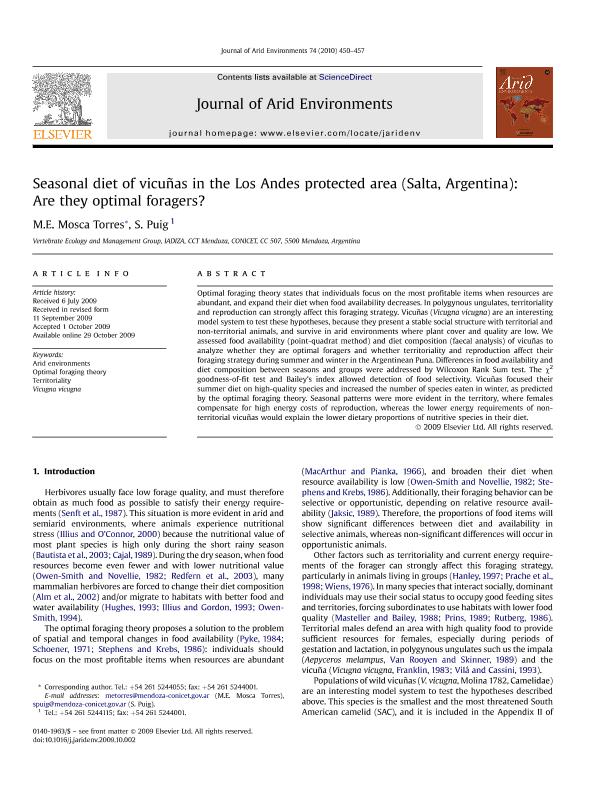Mostrar el registro sencillo del ítem
dc.contributor.author
Mosca Torres, Maria Eugenia

dc.contributor.author
Puig, Silvia

dc.date.available
2019-05-06T14:39:57Z
dc.date.issued
2010-04
dc.identifier.citation
Mosca Torres, Maria Eugenia; Puig, Silvia; Seasonal diet of vicuñas in the Los Andes protected area (Salta, Argentina): Are they optimal foragers?; Academic Press Ltd - Elsevier Science Ltd; Journal of Arid Environments; 74; 4; 4-2010; 450-457
dc.identifier.issn
0140-1963
dc.identifier.uri
http://hdl.handle.net/11336/75590
dc.description.abstract
Optimal foraging theory states that individuals focus on the most profitable items when resources are abundant, and expand their diet when food availability decreases. In polygynous ungulates, territoriality and reproduction can strongly affect this foraging strategy. Vicuñas (Vicugna vicugna) are an interesting model system to test these hypotheses, because they present a stable social structure with territorial and non-territorial animals, and survive in arid environments where plant cover and quality are low. We assessed food availability (point-quadrat method) and diet composition (faecal analysis) of vicuñas to analyze whether they are optimal foragers and whether territoriality and reproduction affect their foraging strategy during summer and winter in the Argentinean Puna. Differences in food availability and diet composition between seasons and groups were addressed by Wilcoxon Rank Sum test. The χ2 goodness-of-fit test and Bailey's index allowed detection of food selectivity. Vicuñas focused their summer diet on high-quality species and increased the number of species eaten in winter, as predicted by the optimal foraging theory. Seasonal patterns were more evident in the territory, where females compensate for high energy costs of reproduction, whereas the lower energy requirements of non-territorial vicuñas would explain the lower dietary proportions of nutritive species in their diet.
dc.format
application/pdf
dc.language.iso
eng
dc.publisher
Academic Press Ltd - Elsevier Science Ltd

dc.rights
info:eu-repo/semantics/openAccess
dc.rights.uri
https://creativecommons.org/licenses/by-nc-sa/2.5/ar/
dc.subject
Arid Environments
dc.subject
Optimal Foraging Theory
dc.subject
Territoriality
dc.subject
Vicugna Vicugna
dc.subject.classification
Otras Ciencias Biológicas

dc.subject.classification
Ciencias Biológicas

dc.subject.classification
CIENCIAS NATURALES Y EXACTAS

dc.title
Seasonal diet of vicuñas in the Los Andes protected area (Salta, Argentina): Are they optimal foragers?
dc.type
info:eu-repo/semantics/article
dc.type
info:ar-repo/semantics/artículo
dc.type
info:eu-repo/semantics/publishedVersion
dc.date.updated
2019-04-03T14:59:28Z
dc.journal.volume
74
dc.journal.number
4
dc.journal.pagination
450-457
dc.journal.pais
Países Bajos

dc.journal.ciudad
Amsterdam
dc.description.fil
Fil: Mosca Torres, Maria Eugenia. Consejo Nacional de Investigaciones Científicas y Técnicas. Centro Científico Tecnológico Conicet - Mendoza. Instituto Argentino de Investigaciones de las Zonas Áridas. Provincia de Mendoza. Instituto Argentino de Investigaciones de las Zonas Áridas. Universidad Nacional de Cuyo. Instituto Argentino de Investigaciones de las Zonas Áridas; Argentina
dc.description.fil
Fil: Puig, Silvia. Consejo Nacional de Investigaciones Científicas y Técnicas. Centro Científico Tecnológico Conicet - Mendoza. Instituto Argentino de Investigaciones de las Zonas Áridas. Provincia de Mendoza. Instituto Argentino de Investigaciones de las Zonas Áridas. Universidad Nacional de Cuyo. Instituto Argentino de Investigaciones de las Zonas Áridas; Argentina
dc.journal.title
Journal of Arid Environments

dc.relation.alternativeid
info:eu-repo/semantics/altIdentifier/doi/http://dx.doi.org/10.1016/j.jaridenv.2009.10.002
dc.relation.alternativeid
info:eu-repo/semantics/altIdentifier/url/https://www.sciencedirect.com/science/article/pii/S0140196309003152
Archivos asociados
